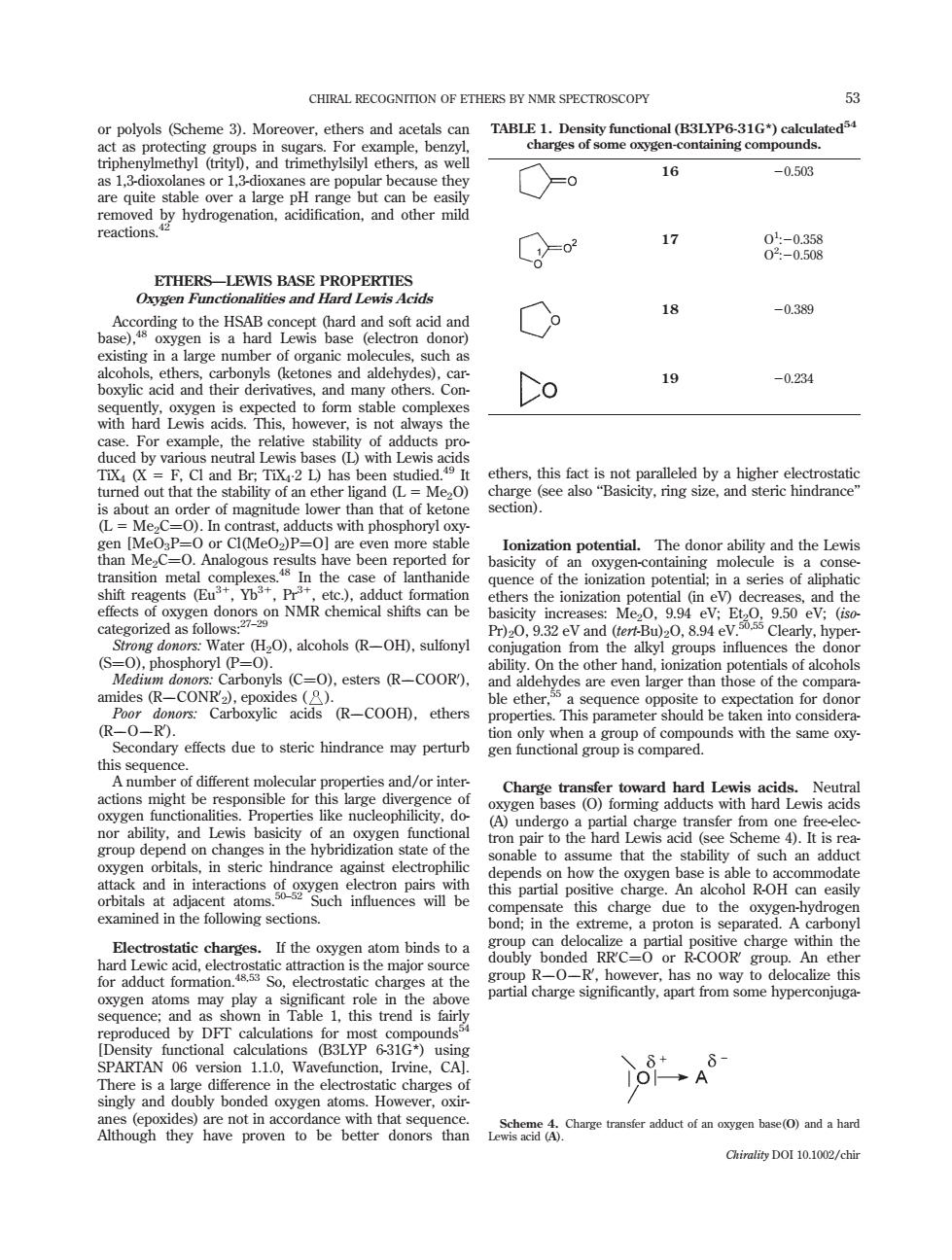正在加载图片...

CHIRAL RECOGNITION OF ETHERS BY NMR SPECTROSCOPY 5 or polyols (Scheme 3).Moreover,ethers and acetals car TABLE1.Density functional(B3LYP6-31G)calculated charges of some oxygen-containing compounds 16 -0.503 reactions 17 8-8 ETHERS-LEWIS BASE PROPERTIES Oxygen Functionalities and Hard Lewis Acids 18 -0.389 alohl tharponyis cani Co 19 -0.234 com ho is not ethers.this fact ralleled by a highe Ionization potential.The donor ability and the Lewis ransition metal In the case thers the onzation pot 950 the de HO).alcohols (R-OH).sulfonyl Pr)9.32 eVand (tert-Bu)2O.8.94eV Clearly,hy )esters (R-COOR) Carboxylie acids (R-COH)ethers Secondary effects due to steric hindrance may perturb same oxy his erties and/or inter nsible for fun 时hh6 ssume that the stability of such an adduct this nartial examined in the following sections. can dele charge within the So,elec atic es at the partial charge ignificantly.apart from some hyperconjug 08A81 L)Chargerct of)hard Chirality DOI 10.1002/chinor polyols (Scheme 3). Moreover, ethers and acetals can act as protecting groups in sugars. For example, benzyl, triphenylmethyl (trityl), and trimethylsilyl ethers, as well as 1,3-dioxolanes or 1,3-dioxanes are popular because they are quite stable over a large pH range but can be easily removed by hydrogenation, acidification, and other mild reactions.42 ETHERS—LEWIS BASE PROPERTIES Oxygen Functionalities and Hard Lewis Acids According to the HSAB concept (hard and soft acid and base),48 oxygen is a hard Lewis base (electron donor) existing in a large number of organic molecules, such as alcohols, ethers, carbonyls (ketones and aldehydes), carboxylic acid and their derivatives, and many others. Consequently, oxygen is expected to form stable complexes with hard Lewis acids. This, however, is not always the case. For example, the relative stability of adducts produced by various neutral Lewis bases (L) with Lewis acids TiX4 (X 5 F, Cl and Br; TiX42 L) has been studied.49 It turned out that the stability of an ether ligand (L 5 Me2O) is about an order of magnitude lower than that of ketone (L 5 Me2C¼¼O). In contrast, adducts with phosphoryl oxygen [MeO3P¼¼O or Cl(MeO2)P¼¼O] are even more stable than Me2C¼¼O. Analogous results have been reported for transition metal complexes.48 In the case of lanthanide shift reagents (Eu31, Yb31, Pr31, etc.), adduct formation effects of oxygen donors on NMR chemical shifts can be categorized as follows:27–29 Strong donors: Water (H2O), alcohols (ROH), sulfonyl (S¼¼O), phosphoryl (P¼¼O). Medium donors: Carbonyls (C¼¼O), esters (RCOOR0 ), amides (RCONR0 2), epoxides ( ). Poor donors: Carboxylic acids (RCOOH), ethers (ROR0 ). Secondary effects due to steric hindrance may perturb this sequence. A number of different molecular properties and/or interactions might be responsible for this large divergence of oxygen functionalities. Properties like nucleophilicity, donor ability, and Lewis basicity of an oxygen functional group depend on changes in the hybridization state of the oxygen orbitals, in steric hindrance against electrophilic attack and in interactions of oxygen electron pairs with orbitals at adjacent atoms.50–52 Such influences will be examined in the following sections. Electrostatic charges. If the oxygen atom binds to a hard Lewic acid, electrostatic attraction is the major source for adduct formation.48,53 So, electrostatic charges at the oxygen atoms may play a significant role in the above sequence; and as shown in Table 1, this trend is fairly reproduced by DFT calculations for most compounds54 [Density functional calculations (B3LYP 6-31G*) using SPARTAN 06 version 1.1.0, Wavefunction, Irvine, CA]. There is a large difference in the electrostatic charges of singly and doubly bonded oxygen atoms. However, oxiranes (epoxides) are not in accordance with that sequence. Although they have proven to be better donors than ethers, this fact is not paralleled by a higher electrostatic charge (see also ‘‘Basicity, ring size, and steric hindrance’’ section). Ionization potential. The donor ability and the Lewis basicity of an oxygen-containing molecule is a consequence of the ionization potential; in a series of aliphatic ethers the ionization potential (in eV) decreases, and the basicity increases: Me2O, 9.94 eV; Et2O, 9.50 eV; (isoPr)2O, 9.32 eV and (tert-Bu)2O, 8.94 eV.50,55 Clearly, hyperconjugation from the alkyl groups influences the donor ability. On the other hand, ionization potentials of alcohols and aldehydes are even larger than those of the comparable ether,55 a sequence opposite to expectation for donor properties. This parameter should be taken into consideration only when a group of compounds with the same oxygen functional group is compared. Charge transfer toward hard Lewis acids. Neutral oxygen bases (O) forming adducts with hard Lewis acids (A) undergo a partial charge transfer from one free-electron pair to the hard Lewis acid (see Scheme 4). It is reasonable to assume that the stability of such an adduct depends on how the oxygen base is able to accommodate this partial positive charge. An alcohol R-OH can easily compensate this charge due to the oxygen-hydrogen bond; in the extreme, a proton is separated. A carbonyl group can delocalize a partial positive charge within the doubly bonded RR0 C¼¼O or R-COOR0 group. An ether group ROR0 , however, has no way to delocalize this partial charge significantly, apart from some hyperconjugaTABLE 1. Density functional (B3LYP6-31G*) calculated54 charges of some oxygen-containing compounds. 16 20.503 17 O1 :20.358 O2 :20.508 18 20.389 19 20.234 Scheme 4. Charge transfer adduct of an oxygen base(O) and a hard Lewis acid (A). CHIRAL RECOGNITION OF ETHERS BY NMR SPECTROSCOPY 53 Chirality DOI 10.1002/chir�